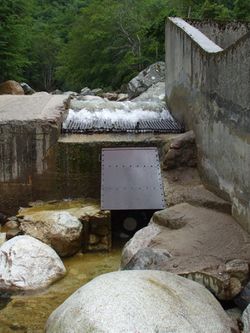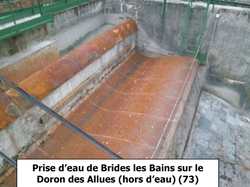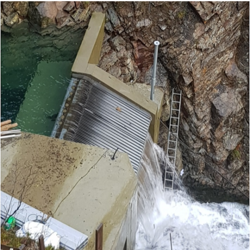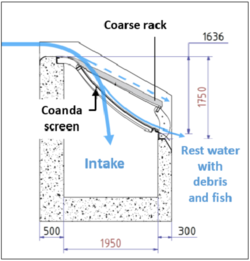Difference between revisions of "Bottom-type intakes (Coanda screen, Lepine water intake, etc)"
Jump to navigation
Jump to search
Bendikhansen (talk | contribs) |
Bendikhansen (talk | contribs) |
||
| Line 1: | Line 1: | ||
| + | NOTE: This article is meant to describe different types of bottom type intakes, but only describes coanda screens in detail. Did not receive input for the others. | ||
| + | |||
[[category:Downstream fish migration measures]][[category:Measures]] | [[category:Downstream fish migration measures]][[category:Measures]] | ||
| + | =Introduction= | ||
| + | [[file:classical_bottom_intake.jpg|thumb|250px|Figure 1: Example of "classical" bottom-type intake in Bocognano in the Gravone river in France.]] | ||
| + | [[file:lepine_bottom_intake.png|thumb|250px|Figure 2: Example of Lépine water intake in the Doron Des Allues river in France.]] | ||
| + | [[file:Coanda_screen_byro_square.png|thumb|250px|Figure 3: Example of Coanda intake in operation at Byro power plant in Norway.]] | ||
| + | [[file:Coanda_schematic.png|thumb|250px|Figure 4: Profile drawing of Coanda screen. The arrows illustrate the flow of water, while a desired part of the water falls through the grid, the rest runs downstream, including fish and debris]] | ||
| + | |||
| + | In mountainous regions, some of the water intakes are of bottom-type, also called Tyrolean intakes, particularly on streams with great sediment transport and sites with complex access. In France, we count many examples of these water intakes, below 1500-1000 m altitude, with natural population of trout upstream. The rack or the perforated plate is included within the downstream weir face, more or less inclined in the downstream direction, so that the trashes and sediments are pushed out by the flow (self-cleaning intake). Three types of such intakes exist: | ||
| + | *“Classical” bottom-type intake: the water goes through a rack with longitudinal bars, more or less inclined in the downstream direction (Figure 1). | ||
| + | *Lépine water-intake: the water falls on a perforated plate. This kind of water-intake is quite frequent in France (Figure 2). | ||
| + | *Coanda water intake: the water goes through a rack with transversal bars using the Coanda effect (Figure 3 and 4). | ||
| + | |||
| + | =[[Methods, tools, and devices]]= | ||
| + | |||
| + | ==During planning== | ||
| + | |||
| + | ==During implementation== | ||
| + | |||
| + | ==During operation== | ||
=Relevant MTDs and test cases= | =Relevant MTDs and test cases= | ||
Revision as of 13:59, 5 April 2020
NOTE: This article is meant to describe different types of bottom type intakes, but only describes coanda screens in detail. Did not receive input for the others.
Contents
Introduction
In mountainous regions, some of the water intakes are of bottom-type, also called Tyrolean intakes, particularly on streams with great sediment transport and sites with complex access. In France, we count many examples of these water intakes, below 1500-1000 m altitude, with natural population of trout upstream. The rack or the perforated plate is included within the downstream weir face, more or less inclined in the downstream direction, so that the trashes and sediments are pushed out by the flow (self-cleaning intake). Three types of such intakes exist:
- “Classical” bottom-type intake: the water goes through a rack with longitudinal bars, more or less inclined in the downstream direction (Figure 1).
- Lépine water-intake: the water falls on a perforated plate. This kind of water-intake is quite frequent in France (Figure 2).
- Coanda water intake: the water goes through a rack with transversal bars using the Coanda effect (Figure 3 and 4).
Methods, tools, and devices
During planning
During implementation
During operation
Relevant MTDs and test cases
Classification table
| Classification | Selection |
|---|---|
| Fish species for the measure | All |
| Does the measure require loss of power production | Operational (requires flow release outside turbine) |
| - | |
| - | |
| Recurrence of maintenance | Irregular at events |
| Which life-stage of fish is measure aimed at | - |
| - | |
| - | |
| Movements of migration of fish | |
| Which physical parameter is addressed | N/A |
| - | |
| - | |
| - | |
| - | |
| - | |
| - | |
| - | |
| Hydropower type the measure is suitable for | Plant in dam |
| Plant with bypass section | |
| Dam height (m) the measure is suitable for | All |
| Section in the regulated system measure is designed for | In dam/power plant |
| - | |
| - | |
| - | |
| River type implemented | Steep gradient (up to 0.4 %) |
| Fairly steep with rocks, boulders (from 0.4 to 0.05 %) | |
| Slow flowing, lowland, sandy (less than 0.05 %) | |
| Level of certainty in effect | Very certain |
| Technology readiness level | TRL 9: actual system proven in operational environment |
| Cost of solution | See cost table |



